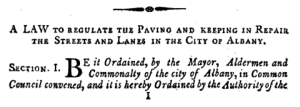Paving of city streets is a big deal these days. Or lack of paving. Or, in poor Troy’s case, paving and then having the fresh pavement collapse into a sinkhole. But it has always been a big deal. Going back to the laws of Albany from 1800, we find an entire law “to regulate the paving and keeping in repair the streets and lanes in the city of Albany,” under which all streets and lanes were to be “paved agreeable” to the following regulations.
The foot-path or walk on each side of a street or lane was to be the breadth of one-fifth part of the street or lane, but no more than twelve feet, “laid or paved with bricks, pebble or other good and sufficient stone.”
Don’t let it be said the Dutch didn’t understand drainage. The middle and remaining part of every street or lane
shall be and remain a cartway or passage for carriages; and shall have a gutter or kennel on each side thereof, and next adjoining the foot-path or walk, and shall be paved with sufficient paving stones, and arched as follows, that is to say: For every eighteen inches such cartway shall measure, from the gutter or kennel to the middle of the street, the arch or rounding of such street or lane, shall be raised one inch, to commence at the respective gutters or kennels. Provided always, That if any street or lane so to be paved, the sides whereof shall not exactly range, the superintendant of such pavement, shall lay out the gutters or outside of the foot-paths, as nearly in a strait line as the street or lane will admit of; that the ascent and descent of every street and lane shall be regulated by such superintendant, and by him reported to the common council for approbation.
There were restrictions on things that stuck out into the street – no canopy, awning, shed, porch, portico, cellar door, platform, stoop or step was to extend more than one tenth of the breadth of the street (or lane), but no more than eight feet from the house or lot.
Driving a horse, cart or other wheeled carriage on a foot-path was forbidden and carried a penalty of fifty cents. If any cartman or other person broke down or injured the walk, they were answerable in damages to the owner or occupant of the house or lot, who in turn was bound to keep the same in repair. It was also not lawful
for any person to lead, drive or ride any horse, or to wheel or drag any wheel or hand barrow along, or to saw or lay any fire-wood, or other thing, on any of the foot-paths or walks aforesaid, whereby the same may be lumbered, or foot-passengers incumbered or endangered, under the penalty of fifty cents for every offence.
Today, we complain that the sidewalks are our responsibility. In 1800, it went out to the middle of the street. Every inhabitant of the city in possession of any house, building or lot fronting any street or lane, “shall at his or her own proper charge and expence, or at the expence of the person whose tenant he or she is, well and sufficiently keep and maintain in good repair, and level, pitch and pave so much of the same street or lane as shall be between such house or lot and the middle of the street or lane opposite thereto …”


1 thoughts on “Streets and Lanes, Gutters and Kennels”